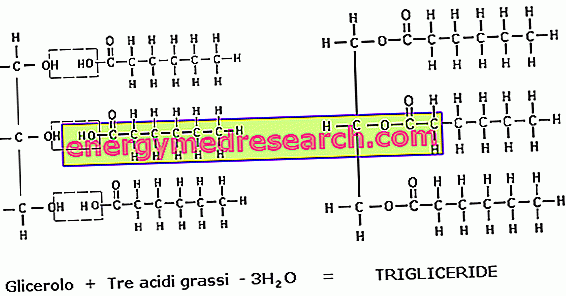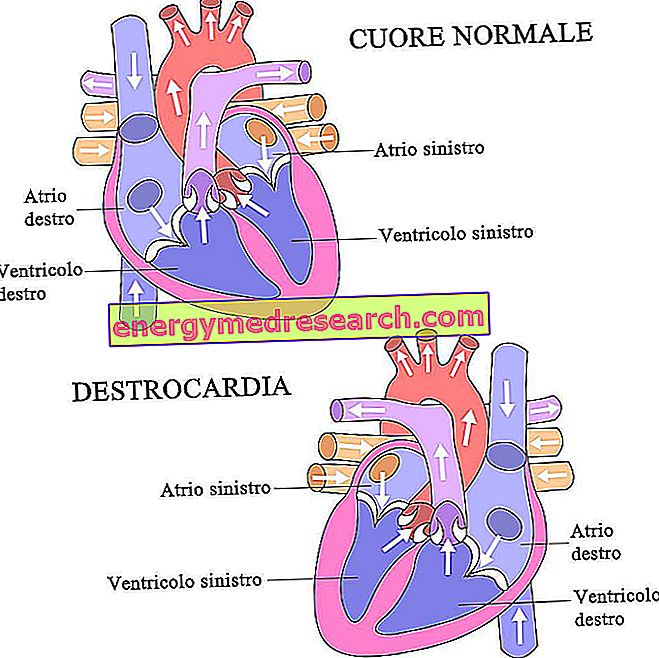Before talking about saturated and unsaturated fats from a health point of view, a broad chemical premise is needed; those who are not interested or already know the topic perfectly, can go directly to the second part of the article.

Definitions and Differences
Very often the terms "lipids", "fats" "and" fatty acids "tend to be used indiscriminately, as if they were synonyms. In reality, these terminologies have a very precise meaning and could not be used randomly. order of these terms, just to stay on the subject, was not the result of a random choice, but of a classification by increasing degree of specificity.Fatty acids, in fact, are structural components of fats, which in turn fall within the lipid category.
But let's proceed by order.
Lipids are substances of biological origin, soluble in organic solvents (acetone, hexane, etc.), but not very soluble in water. Given the generic nature of the definition, the category of lipids brings together many substances, such as triglycerides, phospholipids, cholesterol, sphingolipids, aliphatic alcohols, waxes, terpenes, steroids and fatty acids.
| CLASSIFICATION OF THE MAIN LIPIDS | ||
| Lipids containing glycerol | Neutral fats | Monoglycerides, diglycerides, triglycerides (or mono, di and triacylglycerols), glycerol ethers, glycosylglycerides |
| phosphoglycerides | Phosphatides, phosphatidylglycerols and phosphoinositides | |
| Lipids not containing glycerol | Sphingolipids | Ceramides, sphingomyelins, glycosphingolipids |
| Aliphatic alcohols and waxes | ||
| Terpenes and steroids | ||
| Fatty acids | ||
Chemical Structure
Chemical structure of fatty acids
In the vast majority of cases (90-98%), the lipids introduced with food are represented by triglycerides, also called fats; therefore, as a rule, fats are synonymous with triglycerides.
Triglycerides are formed by the union of a glycerol molecule with three fatty acids, which differentiate into saturated and unsaturated, based on the presence or absence of double bonds.

Saturated fatty acids are formed by a more or less long carbon chain, which begins with a carboxylic group (-COOH), ends with a methyl group (CH3) and has a series of carbon atoms in the central part, each of which is coupled with two hydrogen atoms (CH2).

If this concatenation reflects what is described in every point, we talk about saturated fatty acids; on the contrary, if along the chain one or more pairs of carbon atoms bind to itself only one hydrogen atom per unit, the fatty acid is defined as unsaturated (it has one or more double bonds C = C). If this deficit is recorded only in one point of the chain the fatty acid is called monounsaturated, on the contrary, when two or more pairs of hydrogens are missing, it is called polyunsaturated.
The image on the side and the one below can help you better understand the concepts just explained.

LEGEND:

Fatty acids belong to the category of carboxylic acids; these are very weak acids, different, so to speak, from sulfuric acid, which is a highly corrosive liquid. Generally, free fatty acids have a rather unpleasant taste and smell, but fortunately they are not present in free form in food, except in very small quantities; important concentrations are found in rancid foods and unadjusted seed oils, which before entering the market must necessarily be deprived of their content in free fatty acids (rectification of seed oils).
Molecular conformation and fatty acid length
As shown in the figure (chemical and molecular structure of oleic acid), at the double bonds the molecule loses its linear structure and forms a folding; this is because in nature most double bonds have a cis type configuration.

An example is given by oleic acid, in which the two carbon atoms engaged in the double bond are bound to their own hydrogen on the same plane; a kind of knee is thus formed, which subverts the original linear structure of the fatty acid molecule. All this has repercussions on the degree of fluidity of the food, the greater the more the double bonds abound. This is why vegetable oils, rich in unsaturated fats, are generally liquid at room temperature, while in the same conditions animal fats have a solid consistency.
In elaidic acid, we can instead observe how the two carbon atoms engaged in the double bond are on opposite molecular planes. In this case the fatty acid molecule maintains a linear structure and the foods that contain it will therefore be less fluid than in the previous case. This and other trans fatty acids are quite rare in nature, but are generated by the food industry during the transformation of oils into solid fats (margarines); this result is obtained by means of a process known as hydrogression, with which the hydrogens necessary to saturate the double bond are added, therefore two hydrogen atoms for each pair C = C).
Therefore, summarizing: the presence of a double bond in the aliphatic chain implies the existence of two conformations:
- cis if the two hydrogen atoms bound to the carbons engaged in the double bond are placed on the same plane;
- trans if the spatial arrangement is opposite.
The cis form lowers the melting point of the fatty acid and increases its fluidity.
Length of fatty acids
Another very important characteristic of fatty acids concerns the length of the carbon chain that constitutes them. In fact, short chain fatty acids are soluble in water (therefore, strictly speaking they are not even lipids); as such, they do not require the emulsifying action of bile and are not part of the composition of intestinal micelles, therefore they bypass the lymphatic circulation to be conveyed directly into the blood directed to the liver.
As the chain lengthens, the solubility in water of the fatty acid is reduced and the absorption processes become complicated (see: digestion and fat absorption).
The length of the carbon chain also influences the melting point of the fat, increasing or decreasing it in a proportional way (if the chain lengthens, the melting point increases, ie the fat is more solid, and vice versa).
Triglyceride composition
Within a triglyceride molecule, fatty acids can be homogeneous in length and unsaturation, or vary. For example, a triglyceride can consist of two saturated fatty acids and a polyunsaturated one, or a monounsaturated, a saturated and a polyunsaturated, or again from three monounsaturated and so on.
In nature, every animal fat (fat) or vegetable fat (oil) is therefore made up of a mixture of various lipid molecules, especially triglycerides containing different combinations of fatty acids. When we read on the label or on the nutritional tables that a given food contains a certain percentage of saturated and unsaturated fats, it means that those numbers reflect the content of the two types of fatty acids (saturated and unsaturated). Therefore, it does not matter how the fatty acid molecules are distributed inside the triglycerides, because the health impact of a food depends only on their percentage in relation to the total fatty acid heritage.
Optimal percentages of saturated and unsaturated fats »



